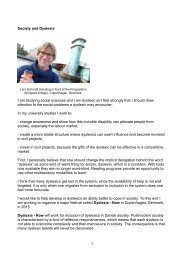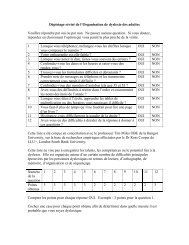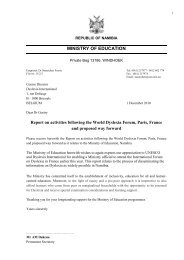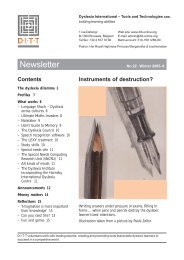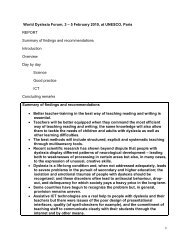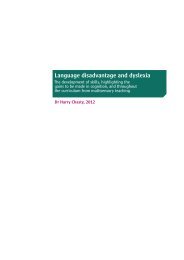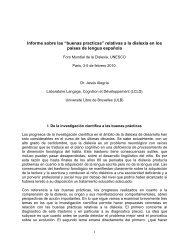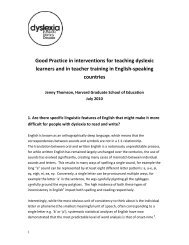Professor Alice Lai - Dyslexia International
Professor Alice Lai - Dyslexia International
Professor Alice Lai - Dyslexia International
You also want an ePaper? Increase the reach of your titles
YUMPU automatically turns print PDFs into web optimized ePapers that Google loves.
World <strong>Dyslexia</strong> Forum<br />
At UNESCO Paris on February 2010<br />
Understanding Chinese Developmental <strong>Dyslexia</strong>:<br />
Meta-linguistic Awareness in both<br />
Chinese Reading and Writing<br />
Dr <strong>Alice</strong> Cheng-<strong>Lai</strong><br />
Manulife Centre for Children with Specific Learning Disabilities<br />
The Hong Kong Polytechnic University<br />
Feb 4th, 2010<br />
1
Abstract<br />
1. Learning to read Chinese requires rather different<br />
insights from young readers than does an alphabetic<br />
system.<br />
2. Chinese readers with dyslexia were best distinguished<br />
from age-matched controls with tasks of morphological<br />
awareness, speeded number naming, and vocabulary<br />
skill;<br />
3. Performance on tasks of visual skills or phonological<br />
awareness failed to distinguish the group.<br />
4. Findings suggest that morphological awareness may<br />
be a core theoretical construct necessary for<br />
explaining variability in reading Chinese.<br />
5. Morphological instruction helped Chinese<br />
Developmental <strong>Dyslexia</strong> to master the structural rules<br />
of different types of characters and to apply the rules<br />
analytically when learning to read and write Chinese<br />
characters.
Behavioral Evidence of Chinese<br />
Developmental <strong>Dyslexia</strong><br />
• Logistic regression analyses revealed that Chinese<br />
readers with dyslexia were best distinguished from agematched<br />
controls with tasks of morphological awareness,<br />
speeded number naming, and vocabulary skill (Shu,<br />
McBride-Chang, Wu & Liu, 2006)<br />
• Path analyses further revealed that a construct of<br />
morphological awareness was the strongest consistent<br />
predictor of a variety of literacy-related skills across both<br />
groups.<br />
• The nature of the meta-linguistic insights that are<br />
important for Chinese reading depends upon the writing<br />
system.
Phonological Awareness in<br />
Chinese<br />
• Children in Mainland China have Pin-Yin (spellsound)<br />
training (which is, the teaching of<br />
phonetics) before they start learning to read<br />
Chinese, and it has been suggested to be<br />
effective in Chinese reading acquisition and<br />
development<br />
• Zhu-Yin-Fu-Hao (sound annotating graphs) in<br />
Taiwan has led to increased phonological<br />
awareness which is important in Chinese<br />
reading acquisition and development
Differences between<br />
Mandarin & Cantonese<br />
No. of Mandarin Cantonese<br />
Tones 4 6 to 9<br />
Distinct “tone syllables” 1300 2000<br />
Syllables before differentiation 403 627<br />
Rimes 36 53<br />
* Cantonese has a more complicated<br />
phonetic system than Mandarin *
Phonetic Systems<br />
In Mainland China:<br />
Spoken dialect: Putonghua<br />
Phonetic system taught: Pin-Yin<br />
In Taiwan:<br />
Spoken dialect: Mandarin<br />
Phonetic system taught: Zhu-Yin-Fu-Hao<br />
In Hong Kong:<br />
Spoken dialect: Cantonese<br />
Phonetic system taught: None
Morphological Awareness Is Important<br />
to Chinese Reading<br />
• Morpheme awareness is the understanding that<br />
words with the same pronunciation and may<br />
have different meanings.<br />
• Homograph awareness is the understanding that<br />
the same character may have different meaning.<br />
• Radical awareness concerns understanding the<br />
role of radicals in the Chinese writing systems
Chinese Characters
Morpheme awareness -<br />
Homophones (Initial)
Morpheme awareness<br />
- Homophones (final)
Homographic awareness (Initial)<br />
由<br />
命
Homographic awareness (final)<br />
水<br />
右
Radical awareness<br />
曷<br />
昌
The role of phonological and morphological awareness<br />
in learning to read Chinese (Shu, Anderson & Li, 2006)<br />
0.67<br />
Vocabulary<br />
Tone<br />
0.00<br />
0.61<br />
Sentence1<br />
0.57<br />
Phonological<br />
1.00<br />
Morpheme1<br />
0.54<br />
0.91<br />
0.77<br />
Sentence2<br />
Cloze<br />
0.70<br />
0.31<br />
0.48<br />
0.57<br />
Reading<br />
0.35<br />
0.97<br />
Morphological<br />
0.68<br />
0.57<br />
0.45<br />
0.13<br />
0.60<br />
Morpheme2<br />
Radical1<br />
Radical2<br />
0.68<br />
0.80<br />
0.98<br />
0.51<br />
Passage<br />
Radical3<br />
0.64
Caes QZY: Phonological awareness<br />
• QZY Control (n=5)<br />
• ----------------------------------------------------------------------------------------------<br />
Auditory memory 0.60 0.96<br />
Identification (single syllable) 0.50 0.88<br />
Identification (word) 0.50 0.92<br />
Syllable identification (real word) 0.94 0.98<br />
(pseudo word) 0.92 1.00<br />
Rime judgment 0.81 0.98<br />
Concernment identification 0.42 0.90<br />
Rime identification 0.42 0.92<br />
Tone identification 0.50 0.90<br />
Phoneme deletion 0.56 0.80<br />
--------------------------------------------------------------------------------------------<br />
QZY’s phonological awareness was week.
Case L: Morphological awareness<br />
L Control(n=5)<br />
-----------------------------------------------------------------------------------<br />
Morpheme judgment 0.64 0.70<br />
Meaning selection 0.25 0.58<br />
-----------------------------------------------------------------------------------<br />
Homophone selection<br />
Radical 0.62 0.91<br />
Morpheme 0.68 0.98<br />
-----------------------------------------------------------------------------------<br />
L performed poorly in morphological awareness tasks.<br />
The unit of Chinese writing system map not onto phonemes or<br />
syllables, but onto morphemes, units defined in term of both sound<br />
and meaning
Morphological Awareness is a Core<br />
Cognitive Construct in Chinese Reading<br />
Significant Variables in First Step Logistic Regression<br />
2<br />
Variable x (1,N = 152)<br />
Morpheme production 49.95<br />
Phoneme deletion 23.53<br />
No. naming 23.97<br />
Vocabulary 27.99<br />
No. repetition 18.04<br />
Note: Chi-square is the change in -2log-likelihood if the predictor is removed<br />
from the model. All ps
Morphological Awareness is a Core<br />
Cognitive Construct in Chinese Reading<br />
Prediction of <strong>Dyslexia</strong><br />
Predicted<br />
Observed <strong>Dyslexia</strong> Control Prediction<br />
Rate<br />
Dyslexic 59 16 78.7%<br />
Control 18 59 76.7%<br />
Production Rate 76.7% 78.7%<br />
Note: Cutoff value p
Model of Chinese character<br />
recognition<br />
Morpheme<br />
production<br />
-.491***<br />
-.485***<br />
-.327***<br />
-.228***<br />
Number<br />
naming<br />
Vocabulary<br />
.509***<br />
-.115*<br />
.200**<br />
2<br />
R =.633<br />
Character<br />
Reading<br />
-.261***<br />
-.377***<br />
Phoneme<br />
delection<br />
.192**<br />
*p
Model of Chinese character<br />
dictation<br />
Morpheme<br />
production<br />
.491***<br />
-.485***<br />
-.327***<br />
-.228***<br />
Number<br />
naming<br />
Vocabulary<br />
.422***<br />
-.170*<br />
.114<br />
2<br />
R =.474<br />
Character<br />
Dictation<br />
-.261***<br />
-.377***<br />
Phoneme<br />
delection<br />
.193**<br />
*p
Model of Chinese reading<br />
comprehension<br />
Morpheme<br />
production<br />
.491***<br />
-.485***<br />
-.327***<br />
-.228***<br />
Number<br />
naming<br />
.320***<br />
-.190*<br />
2<br />
R =.633<br />
Comprehension<br />
Vocabulary<br />
.152**<br />
-.261***<br />
-.377***<br />
Phoneme<br />
delection<br />
.176**<br />
*p
Chinese Morphological<br />
Awareness Instruction
多 媒 體 中 英 文 訓 練 軟 件
Chinese Morphological Awareness Instruction<br />
( HK PolyU, 2007)<br />
• Pictographic characters<br />
• Simple ideographic characters<br />
• Compound ideographic characters<br />
• Semantic phonetic compound characters<br />
• Orthographical awareness<br />
• Selection of radical elements<br />
• Homophones differentiation<br />
• Homograph awareness<br />
• Reading and writing activities
多 媒 體 中 英 文 訓 練 軟 件
多 媒 體 中 英 文 訓 練 軟 件
Chinese Morphological<br />
Awareness Training Results<br />
(HK PolyU, 2008)
Morphological Awareness<br />
Measures<br />
Morpheme production<br />
The experimenter gave the word ‘cao3di4’<br />
(meaning lawn), the child was asked to produce a<br />
new word with the morpheme [cao3] had the<br />
same meaning as it did in ‘cao3di4’.. One<br />
acceptable answer would be xiao3cao3 (meaning<br />
grass). The child was also asked to say a word<br />
that included the morpheme [cao3] in which its<br />
meaning was different from that in ‘cao3di’
Pretest<br />
Posttest<br />
% p<br />
Exp. Mean 10.71 13.55 26.52% ***
Pseudo Word<br />
Please put a ‘tick’ next to the real characters, and a ‘cross’ next to the<br />
pseudo characters with illegal structures
Pretest<br />
Posttest<br />
% p<br />
Exp. Mean 24.55 26.93 9.69% ***
Instructions:<br />
Morphological Radical<br />
In every trial you will hear a complete sentence, but the same sentence<br />
in written form that you can see below misses a character. Circle the<br />
missed character from the four options provided.<br />
Practice:<br />
野 __ 是 一 種 非 常 兇 猛 的 動 物 。<br />
A boar is a kind of very fierce animal.<br />
(1) 渚 (islet) (2) 猪 (pig) (3) 諸 (various) (4) 著 (manifest)
Pretest<br />
Posttest<br />
% p<br />
Exp. Mean 12.32 15.87 28.81% ***
Comprehension<br />
Instructions<br />
There are some sentences below. Some are acceptable while the<br />
others are unacceptable. Please read silently and judge whether<br />
These sentences are acceptable or not. If you think the sentence is<br />
acceptable, put a ‘tick’ in the bracket, if not, put a ‘cross’ in the<br />
bracket.<br />
Examples<br />
我 喜 歡 吃 書 本 I like eating books<br />
()<br />
我 喜 歡 看 電 視 I like watching TV programs ()
Pretest<br />
Posttest<br />
% p<br />
Exp. Mean 15.55 17.15 10.29% ***
Word Identification<br />
Which of the following is the character ‘cun1’ in the<br />
word ‘cun1 tin1’ (Spring) …..Yes, it’s the first one,<br />
you’re right, so you should circle the option 1. All right,<br />
we will now start, and I will read twice for each item.<br />
Listen carefully.<br />
Practice:<br />
____ tin1<br />
1) cun1 (Spring) 2) ha6 (Summer) 3) cau1 (Autumn) 4)<br />
dong1 (Winter)
Pretest<br />
Posttest<br />
% p<br />
Exp. Mean 22.82 26.08 14.29% ***
Word Meaning<br />
There are pairs of words in the following. Each pair<br />
has one common character. You have to judge<br />
whether the common character of the pair of words<br />
has the same meaning.<br />
For example, the ‘mei5’ in ‘mei5 lai6’ (beautiful) is<br />
different from that in ‘mei5 gwok3’ (United States), so<br />
you should put a cross in the bracket.
Pretest<br />
Posttest<br />
% p<br />
Exp. Mean 12.87 14.73 14.45% ***
Morphological Instruction and Teacher<br />
Training in Beijing & Hong Kong<br />
• From various experimental findings, it could be concluded that<br />
explicit teaching of the internal structures of Chinese characters<br />
would be beneficial to character learning<br />
• A well-structured pedagogy of morphological instruction should<br />
enable children to use the structural rules analytically when they are<br />
exposed to any new or unfamiliar Chinese characters<br />
• Teachers in Beijing and Hong Kong found the pedagogy of<br />
morphological instruction useful for children with dyslexia. They<br />
observed that children can make use of such analytic strategies in<br />
learning any new Chinese characters, which indicated that they<br />
have learned the morphological rules of the Chinese orthography.
Thank You!<br />
Dr <strong>Alice</strong> Cheng<br />
ssalai@inet.polyu.edu.hk<br />
Manulife Centre for Children with<br />
Specific Learning Disabilities<br />
The Hong Kong Polytechnic University<br />
www.mccsld.org<br />
41



